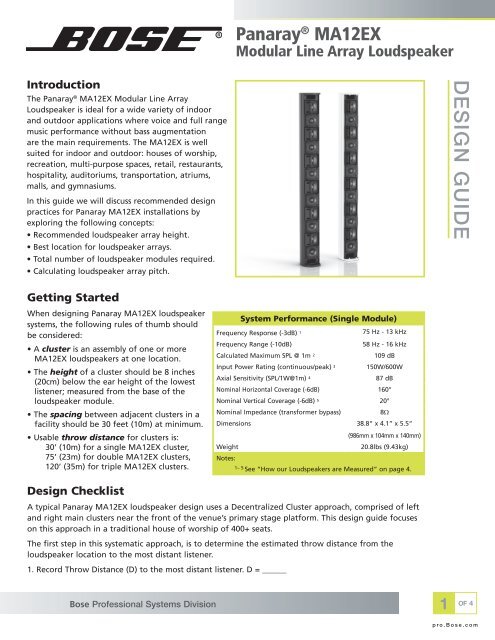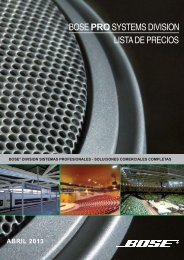Design Guide for Panaray MA12EX Modular Line Array ... - Bose
Design Guide for Panaray MA12EX Modular Line Array ... - Bose
Design Guide for Panaray MA12EX Modular Line Array ... - Bose
Create successful ePaper yourself
Turn your PDF publications into a flip-book with our unique Google optimized e-Paper software.
Introduction<br />
The <strong>Panaray</strong> ® <strong>MA12EX</strong> <strong>Modular</strong> <strong>Line</strong> <strong>Array</strong><br />
Loudspeaker is ideal <strong>for</strong> a wide variety of indoor<br />
and outdoor applications where voice and full range<br />
music per<strong>for</strong>mance without bass augmentation<br />
are the main requirements. The <strong>MA12EX</strong> is well<br />
suited <strong>for</strong> indoor and outdoor: houses of worship,<br />
recreation, multi-purpose spaces, retail, restaurants,<br />
hospitality, auditoriums, transportation, atriums,<br />
malls, and gymnasiums.<br />
In this guide we will discuss recommended design<br />
practices <strong>for</strong> <strong>Panaray</strong> <strong>MA12EX</strong> installations by<br />
exploring the following concepts:<br />
• Recommended loudspeaker array height.<br />
• Best location <strong>for</strong> loudspeaker arrays.<br />
• Total number of loudspeaker modules required.<br />
• Calculating loudspeaker array pitch.<br />
Getting Started<br />
When designing <strong>Panaray</strong> <strong>MA12EX</strong> loudspeaker<br />
systems, the following rules of thumb should<br />
be considered:<br />
• A cluster is an assembly of one or more<br />
<strong>MA12EX</strong> loudspeakers at one location.<br />
• The height of a cluster should be 8 inches<br />
(20cm) below the ear height of the lowest<br />
listener; measured from the base of the<br />
loudspeaker module.<br />
• The spacing between adjacent clusters in a<br />
facility should be 30 feet (10m) at minimum.<br />
• Usable throw distance <strong>for</strong> clusters is:<br />
30’ (10m) <strong>for</strong> a single <strong>MA12EX</strong> cluster,<br />
75’ (23m) <strong>for</strong> double <strong>MA12EX</strong> clusters,<br />
120’ (35m) <strong>for</strong> triple <strong>MA12EX</strong> clusters.<br />
<strong>Design</strong> Checklist<br />
<strong>Panaray</strong> ® <strong>MA12EX</strong><br />
<strong>Modular</strong> <strong>Line</strong> <strong>Array</strong> Loudspeaker<br />
A typical <strong>Panaray</strong> <strong>MA12EX</strong> loudspeaker design uses a Decentralized Cluster approach, comprised of left<br />
and right main clusters near the front of the venue’s primary stage plat<strong>for</strong>m. This design guide focuses<br />
on this approach in a traditional house of worship of 400+ seats.<br />
The first step in this systematic approach, is to determine the estimated throw distance from the<br />
loudspeaker location to the most distant listener.<br />
1. Record Throw Distance (D) to the most distant listener. D = ______<br />
System Per<strong>for</strong>mance (Single Module)<br />
Frequency Response (-3dB) 1 75 Hz - 13 kHz<br />
Frequency Range (-10dB) 58 Hz - 16 kHz<br />
Calculated Maximum SPL @ 1m 2 109 dB<br />
Input Power Rating (continuous/peak) 3 150W/600W<br />
Axial Sensitivity (SPL/1W@1m) 4 87 dB<br />
Nominal Horizontal Coverage (-6dB) 160°<br />
Nominal Vertical Coverage (-6dB) 5 20°<br />
Nominal Impedance (trans<strong>for</strong>mer bypass) 8Ω<br />
Dimensions 38.8” x 4.1” x 5.5”<br />
(986mm x 104mm x 140mm)<br />
Weight 20.8lbs (9.43kg)<br />
Notes:<br />
1– 5 See “How our Loudspeakers are Measured” on page 4.<br />
<strong>Bose</strong> Professional systems Division 1<br />
<strong>Design</strong> guiDe<br />
OF 4<br />
pro.<strong>Bose</strong>.com
<strong>Panaray</strong> ® <strong>MA12EX</strong><br />
<strong>Modular</strong> <strong>Line</strong> <strong>Array</strong> Loudspeaker<br />
<strong>Design</strong> Checklist (Continued)<br />
The next step is to determine the number of<br />
loudspeaker modules required <strong>for</strong> each cluster. For<br />
flat seating areas, use the chart in Figure 1, and<br />
draw a vertical line corresponding to the throw<br />
distance recorded in step 1. Then draw a horizontal<br />
line corresponding to the estimated mid-band<br />
reverberation time of the room in seconds. Note<br />
the number of <strong>MA12EX</strong> modules indicated by the<br />
shaded area, where the two lines intersect.<br />
2a. Record <strong>MA12EX</strong> loudspeakers<br />
required per cluster = ______<br />
For raked seating areas (seats mounted on a sloped<br />
floor), refer to visual elements shown in Figure 2<br />
to determine the number of loudspeaker modules<br />
required to provide appropriate vertical coverage to<br />
the listeners.<br />
The equation <strong>for</strong> determining this is as follows:<br />
Ha = (D x Sina) + (L + (8” or 20cm))<br />
2b. Record <strong>MA12EX</strong> loudspeakers<br />
required per cluster = ______<br />
<strong>Array</strong><br />
Height (H a )<br />
Mid-Band Reverberation Time (RT 60)<br />
Throw Distance (D)<br />
5.0 Sec.<br />
4.5 Sec.<br />
4.0 Sec.<br />
3.5 Sec.<br />
3.0 Sec.<br />
2.5 Sec.<br />
2.0 Sec.<br />
1.5 Sec.<br />
1.0 Sec.<br />
0.5 Sec.<br />
Floor Rake (α)<br />
Figure 2: Raked Seating Factors<br />
1x <strong>MA12EX</strong><br />
15 ft<br />
5 m<br />
30 ft<br />
9 m<br />
2x <strong>MA12EX</strong><br />
45 ft<br />
13 m<br />
60 ft<br />
18 m<br />
75 ft<br />
23 m<br />
3x <strong>MA12EX</strong><br />
90 ft<br />
27 m<br />
100 ft<br />
30 m<br />
Loudspeaker to most distant listener (D)<br />
Figure 1: Loudspeaker Module Quantity Matrix<br />
Listener's<br />
Ear Height (L)<br />
Farthest<br />
Listener<br />
120 ft<br />
35 m<br />
2<br />
<strong>Design</strong> guiDe<br />
OF 4<br />
pro.<strong>Bose</strong>.com
<strong>Panaray</strong> ® <strong>MA12EX</strong><br />
<strong>Modular</strong> <strong>Line</strong> <strong>Array</strong> Loudspeaker<br />
<strong>Design</strong> Checklist (Continued)<br />
Once the number of loudspeaker modules per cluster is established, the next step is to determine the<br />
total number of loudspeaker modules required <strong>for</strong> the entire project. This quantity is derived by multiplying<br />
the number of loudspeaker modules per cluster, by the number of clusters required <strong>for</strong> the project.<br />
In this sample design, we are using<br />
two cluster locations by referencing<br />
our spacing rule of thumb to maintain<br />
30’ (10m) between adjacent<br />
cluster locations. These locations<br />
are indicated in Figure 3 as circles<br />
at the front edge of the stage and<br />
the direction of cluster aiming is<br />
indicated by blue arrows.<br />
3. Record the total <strong>MA12EX</strong><br />
loudspeakers required ______<br />
The final step in this design process<br />
is to determine if any pitch is<br />
required <strong>for</strong> each of the clusters.<br />
In most cases pitch is unnecessary, but two unique situations warrant the use of pitch:<br />
• To prevent a late-arriving reflection at the front of the seating area off of a reflective rear wall.<br />
• To ensure unobstructed line-of-sight coverage to all listeners.<br />
Pitching Rule: An <strong>MA12EX</strong> loudspeaker should be mounted and pitched so the nearest seated listener’s<br />
ears and the most distant standing listener’s ears, are within the vertical coverage pattern of the array.<br />
See Figure 4 <strong>for</strong> an illustration of this effect.<br />
1 to 5 degrees is the typical maximum<br />
pitch necessary to compensate<br />
<strong>for</strong> the effects mentioned<br />
above. Once a cluster is pitched,<br />
coverage at the rear of the seating<br />
area should be verified by<br />
listening tests, to ensure that all<br />
listener’s are within the array’s<br />
vertical coverage pattern.<br />
Figure 3: Distributed Cluster Locations<br />
Figure 4: Cluster Pitch Example<br />
3<br />
<strong>Design</strong> guiDe<br />
OF 4<br />
pro.<strong>Bose</strong>.com
dg_panaray_ma12ex_v1.4<br />
<strong>Panaray</strong> ® <strong>MA12EX</strong><br />
<strong>Modular</strong> <strong>Line</strong> <strong>Array</strong> Loudspeaker<br />
Rigging<br />
<strong>MA12EX</strong> loudspeakers can be mounted as a single<br />
element, or stacked in multiples, to achieve line array<br />
per<strong>for</strong>mance. <strong>Bose</strong> ® <strong>MA12EX</strong> loudspeaker mounting<br />
brackets are available and tested <strong>for</strong> use with single-,<br />
double-, and triple-stack <strong>MA12EX</strong> loudspeaker<br />
installations. For installations of four or more <strong>MA12EX</strong><br />
loudspeakers, obtain your mounting system from a<br />
reputable manufacturer. Select a system design that<br />
works <strong>for</strong> your loudspeaker of choice and its intended<br />
use. Always have a licensed professional engineer<br />
review the design and fabrication <strong>for</strong> structural<br />
integrity and safety in the intended application.<br />
How our Loudspeakers<br />
are Measured<br />
1. Frequency Response and Range<br />
Data is the average response in the typical coverage<br />
area with the recommended equalization applied.<br />
2. Calculated Max SPL<br />
Calculated based on input sensitivity with<br />
recommended equalization applied, and maximum<br />
input power rating exclusive of power compression.<br />
3. Input Power Rating<br />
Pink noise with a 6 dB crest factor is bandpass limited<br />
to the operating range of the loudspeaker and<br />
applied <strong>for</strong> 100 hours.<br />
4. Axial Sensitivity<br />
Full-bandwidth pink noise with recommended<br />
equalization amplified to a level of 1 watt<br />
and applied to the loudspeaker in an anechoic<br />
environment.<br />
5. Nominal Vertical Coverage<br />
Vertical coverage varies by number of modules<br />
vertically arrayed and distance from line-source<br />
boundary. Use <strong>Bose</strong> ® Modeler ® sound system software<br />
<strong>for</strong> the best prediction.<br />
More In<strong>for</strong>mation<br />
Technical literature and other materials are available<br />
at pro.<strong>Bose</strong>.com.<br />
All in<strong>for</strong>mation subject to change without notice.<br />
©2009 <strong>Bose</strong> Corporation. <strong>Bose</strong>, Modeler, and <strong>Panaray</strong> are registered<br />
trademarks of <strong>Bose</strong> Corporation in the U.S. and other countries.<br />
Other marks are the property of their owners.<br />
4<br />
<strong>Design</strong> guiDe<br />
OF 4<br />
pro.<strong>Bose</strong>.com



